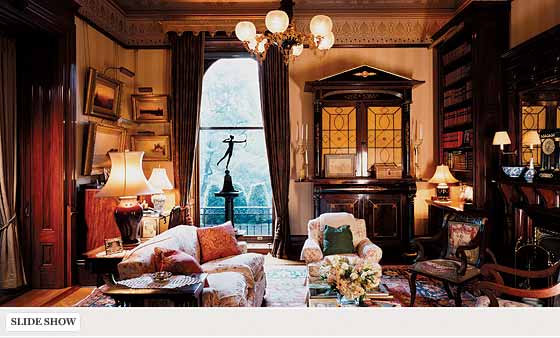
PAST
Owner: Leonard and Felicia Bernstein
Years in residence: 1974 to 1996
Leonard’s preferred party game was playing Name That Tune on the harpsichord.
PRESENT
Owner: Anonymous
Year purchased: 1996
The 1829 Robert Fisher bookcase in the library was part of the “Art and the Empire City” exhibit at the Metropolitan Museum of Art.
They couldn’t have started from a more different point,” Jamie Bernstein says, as she considers the differences between what her family’s apartment looked like in the seventies, when her parents—Leonard and Felicia Bernstein—were at the head of New York’s social scene, and now.
“It’s a different way of putting a house together,” she says one afternoon during a conversation with the interior designer Gail Jacobs, an old family friend who worked on this apartment when the Bernsteins bought it. “Our stuff was accumulated higgledy-piggledy over the decades, instead of basically assembling everything from scratch, where you buy the best of everything and smush it all together.”
“They had all this furniture!” Jacobs exclaims. “It was the history of the entire family. We bought very little.” Her biggest challenge came in 1978, when Leonard summoned her back after Felicia died. Jacobs had six weeks to turn her romantic bedroom into a music room and study for him.
The somewhat random, happy harmony of that apartment was a reaction, says Bernstein, to the more formal Park Avenue apartment they’d moved from, which had been decorated by Keith Irvine. “When they moved from the Osborne on 57th Street, my father was at the height of his New York Philharmonic career,” says Bernstein, “and my mother felt that he needed appropriately grand digs so they could have all their social events.”
“The apartment was great to do, because Lenny and Felicia were everything you would want in a client but certain about what they didn’t want,” adds Jacobs. Turning to Bernstein, she says, “We would ask your father his opinion, and it was fine as long as the questions lasted no more than 30 seconds.”
The current owner, an architect, probably wouldn’t describe the fifteen-room apartment now as a “smush.” And in a way, she shares a sensibility with the Bernsteins, since much of what’s there now was drawn from her late husband’s impressive art and furniture collection. He’d been living in the building before they met, and after they married, they bought the Bernsteins’ apartment, in what both parties characterize as one of the most amicable real-estate transactions ever; the Bernstein children gave the new owners a piece of sheet music their father had written called “Take Care of This House,” on which they inscribed, “We know you will.” No doubt Leonard would approve of the four-poster Duncan Phyfe canopy bed in the master bedroom, the John Singer Sargent paintings in their original Stanford White frames, the Augustus Saint-Gaudens statue of Diana in the library window. Masterpieces, in other words, are still very much in residence.
